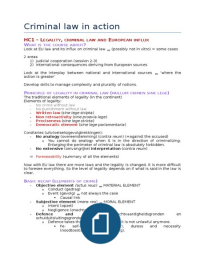Criminal law in action
HC1 – LEGALITY, CRIMINAL LAW AND EUROPEAN INFLUX
WHAT IS THE COURSE ABOUT?
Look at EU law and its influx on criminal law (possibly not in vitro) = some cases
2 areas
1) Judicial cooperation (session 2-3)
2) International consequences deriving from European sources
Look at the interplay between national and international sources ‘where the
action is greater’
Develop skills to manage complexity and plurality of notions.
PRINCIPLE OF LEGALITY IN CRIMINAL LAW (NULLUM CRIMEN SINE LEGE)
The traditional elements of legality (in the continent)
Elements of legality:
- No crime without law
- No punishment without law
- Written law (sine lege stripta)
- Non retroactivity (sine proevia lege)
- Preciseness (sine lege stricta)
- Democratic element (sine lege parlamentaria)
Corollaries (uitvloeisels/gevolgtrekkingen):
- No analogy (overeenstemming) (contra reum) (=against the accused)
o You cannot do analogy when it is in the direction of criminalizing.
Enlarging the perimeter of criminal law is absolutely forbidden.
- No extensive (omvangrijke) interpretation (contra reum)
Foreseeability (summary of all the elements)
Now with EU law there are more laws and the legality is changed. It is more difficult
to foresee everything. So the level of legality depends on if what is said in the law is
clear.
BASIC RECAP (ELEMENTS OF CRIME)
- Objective element (actus reus) MATERIAL ELEMENT
o Conduct (gedrag)
o Event (gevolg) not always the case
Causal link
- Subjective element (mens rea) MORAL ELEMENT
o Intent (opzet)
o Negligence (onachtzaamheid)
- Defence and excuses (rechtvaardigheidsgronden en
schulduitsluitingsgronden)
o Defence takes the illicit element away, it is not unlawful anymore.
Fe: self-defence (noodweer), duress and necessity
(noodtoestand), mistake (dwaling).
, o Excuse does not take the illicit element away. The crime is still unlawful
but the guilt of the offender is taken away, he’s been excused.
LEGALITY AND THE PRESENT
- Legality connected to law
o Traditional (enlightenment) principle
o Logic? Protective logic (for citizens, for offenders)
o Are things changing?
Criminal law:
1) Substantive (materieel) legality / criminal law:
a. Consists of written statutory rules passed by legislature that govern
how people behave. These rules, or laws, define crimes and set forth
punishment. They also define our rights and responsibilities as citizens.
b. It is used to determine whether a crime or tort has been committed,
define what charges may apply and decide whether the evidence
supports the charges.
c. It tells everyone what to do. It’s about the relationship with the state
and the individual suspect (and victims). The state should act in a way
to get a proper and fair verdict.
d. It allows to proceed, it serves the protective logic.
2) Procedural legality / criminal law:
a. Governs the mechanics of how a legal case flows, including steps to
process a case.
b. Procedure involves a larger sets of interests (accused, defendants,
suspects, victims, prosecutors, police, judges)
c. Procedure legality connected to law and fundamental rights (do as the
law says and not to harm fundamental rights). We see fundamental
rights as a boundary to what procedural law can do.
d. Procedural legality protective logic (for citizens, for all parties)
e. More flexible (workability) – but Scoppola ECtHR
f. Procedural law does not tell ppl what to do, tell only a group of ppl
what to do
LEGALITY AND THE PRESENT AND EUROPE
- What if you have more than one law?
o Different standards, more complexity
- What if you have different standards of rights?
- What is the impact on case-law?
o Civil law vs. common law (=judges make the law)
o Look at the ‘end-product’ of legality
EUROPE AND CRIMINAL JUSTICE
After 2nd WW, common aim to:
- Assure uniform protection of fundamental rights and
- To strenghten cooperation in criminal matters between countries
Original protagonist: Council Of Europe charter & judicial body
COE CONVENTIONS
- Fundamental rights
o ECHR (+ ECtHR)
- Cooperation- Several Conventions:
, o Extradition (1957), punishment road offences (1963), mutual
assistance (1959), transfer of prisoners (1983), transfer of proceedings
(1972), etc. + protocols
- More and more also criminal law (soft harmonization approach)
o Conventions (& Recommandations)
o Council of Europe Convention on preventing and combating violence
against women and domestic violence (Istanbul 2011)
o Council of Europe Convention against cyber crime (Budapest 2001)
List of all COE treaties:
http://conventions.coe.int/Treaty/Commun/ListeTraites.asp?CM=8&CL=ENG
EU DEVELOPMENT IN CRIMINAL LAW
Originally: criminal justice out of EC. Before the union, when Europe was an
economic community there was no criminal law.
Development of criminal law approximation may be divided into three main
stages:
- The first period refers to the time before the adoption of the Maastricht Treaty
(1992),
- The second period started with the TEU as modified in Amsterdam and Nice,
- The third period is the marked by the Lisbon Treaty.
FROM MAASTRICHT …
- 3 pillars
- Ad hoc legislative acts for 3rd pillar
o Decisions, Framework decisions, EU Conventions, common positions
- Intergovernmental approach (unanimity)
- Marginal role of Parliament
- No direct applicability of legislation
- Limited competence ECJ
… TO LISBON
- Pillars torn down
- Union law instead of community law
- Legal instruments:
o No more framework decisions: but they are still valid and binding and
applicable
o Directives and Regulations only (art. 288)
- Full ECJ competence (infringement proceedings)
- Charter of Fundamental Rights binding (art. 6 TEU)
TRANSITION PERIOD OLD THIRD PILLAR LEGISLATION: 1 DEC 2009 – 1 DEC
2014
- MS remain bound
- ECJ’s competence on 35 TEU (old)
- COM may not start infringement proceedings against MS
- COM uses evaluation and monitoring
- ECJ may give preliminary rulings




